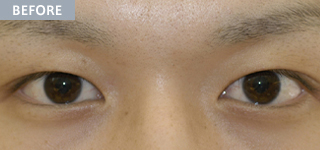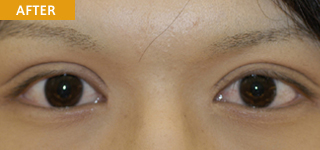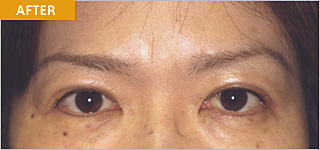Incision of the inner corner of the eye
Incision of the inner corner of the eye (commonly called a medial canthoplasty) sculpts the skin that covers the inner corner of the eye, called the Mongolian fold, which is distinctive to the Asian and Japanese peoples. The procedure not only changes the shape of the eye but the expression of the eyes at well. It can make the eyes seem larger and closer to the center of the face and make the inner corner of the eye seem more Western—in other words, it can give the eyes a look akin to a parallel double eyelid.
At times, a desired double eyelid cannot be sculpted due to the existence of the Mongolian fold, so this procedure will often be performed in conjunction with a double-eyelid procedure. This procedure may also be performed when the shape of an existing double eyelid is being significantly altered.
At times, a desired double eyelid cannot be sculpted due to the existence of the Mongolian fold, so this procedure will often be performed in conjunction with a double-eyelid procedure. This procedure may also be performed when the shape of an existing double eyelid is being significantly altered.
| Duration of Surgery | ~1 hour |
|---|---|
| Period of swelling following surgery | 2-3 days |
| Recovery period | 2-3 days |
| Hospital visits following surgery | Removal of sutures within 1 week and re-examination 1 month and 3 months after surgery |
| Cost | ¥210,000 |
Incision of the inner corner of the eye - Surgery Details
【Z shaping】

1: A Z-shaped incision is made at the tip of the inner corner of the eye 2: Two triangular skin flaps are created 3: The two skin flaps exchange places 4: Sutures are put in place

1: A Z-shaped incision is made at the tip of the inner corner of the eye 2: Two triangular skin flaps are created 3: The two skin flaps exchange places 4: Sutures are put in place

5: The same occurs with the skin flap on the opposite side 6: The skin flap changes places to cover the shortfall 7-8: The excess skin is trimmed
 9: The shape is lined up with the adjoining wall
10: Sutures are properly put in place
11: Scarring will be in a reverse Z shape
9: The shape is lined up with the adjoining wall
10: Sutures are properly put in place
11: Scarring will be in a reverse Z shape【W shaping】

1: A W-shaped mark is made at the inner corner of the eye
2: Skin is excised in the mark along the Mongolian fold. The inner canthus is exposed
3: The skin at the excision is sutured. At this time, by suturing so the triangular skin flap in the center of the W is tucked into the inner canthus, a defect due to the excision can be prevented
4: The rest of the area is properly sutured; finished

1: A W-shaped mark is made at the inner corner of the eye
2: Skin is excised in the mark along the Mongolian fold. The inner canthus is exposed
3: The skin at the excision is sutured. At this time, by suturing so the triangular skin flap in the center of the W is tucked into the inner canthus, a defect due to the excision can be prevented
4: The rest of the area is properly sutured; finished
Incision of the inner corner of the eye - Case Photos



Widening of the lower eyelid (almond eye/drooping eye)
Procedure that widens the vertical width of the eye. Performed to widen the outer side of the eye in particular. Since the incisions are made on the conjunctival side and the inside of the eyelid, there is basically no scarring. In cases where there is a considerable degree of lowering involved, it is possible to enlarge the eye by making an incision beneath the lower eyelid and suturing. By lowering the lower canthus, a gentle almond shape is created postoperatively. The procedure not only widens the eye but is also effective for those concerned about eyes that are slanted upward or drooping eyes.
| Duration of Surgery | 1-2 hours |
|---|---|
| Period of swelling following surgery | 3-7 days |
| Recovery period | 1 week - 10 days |
| Hospital visits following surgery | Removal of sutures 1 week after surgery |
| Cost | ¥1,050,000 |
Widening of the lower eyelid (almond eye/drooping eye) - Surgery Details
Skin side
 1: Resection lines are marked on the skin
2: A portion of the skin and orbicularis oculi muscle 2-4 mm wide is resected
3: The skin is stitched together below
4: Sutures; finished
1: Resection lines are marked on the skin
2: A portion of the skin and orbicularis oculi muscle 2-4 mm wide is resected
3: The skin is stitched together below
4: Sutures; finished
 1: Resection lines are marked on the skin
2: A portion of the skin and orbicularis oculi muscle 2-4 mm wide is resected
3: The skin is stitched together below
4: Sutures; finished
1: Resection lines are marked on the skin
2: A portion of the skin and orbicularis oculi muscle 2-4 mm wide is resected
3: The skin is stitched together below
4: Sutures; finished結膜側

1: A 2-cm excision is made along the edge of the tarsus
2: The tarsus and the capsulo-palpebra fascia are sewn together
3: Sutures are put in place; finish

1: A 2-cm excision is made along the edge of the tarsus
2: The tarsus and the capsulo-palpebra fascia are sewn together
3: Sutures are put in place; finish

Sculpting of the outer corner of the eye
Just as with the inner corner, this procedure makes the eye appear bigger. While incising the inner corner makes the eyes appear larger and closer to the center of the face, however, incising the outer corner brings the eyes closer toward the ears in addition to making them appear larger by way of a very slight incision. By extending the outer corner of the eye, the curvature of the lower eyelid can be changed, and the slant of the eye can be adjusted. The procedure is appropriate not only for those who want larger eyes but for those with concerns about eyes that are slanted upward or drooping eyes.
| Duration of Surgery | ~1 hour |
|---|---|
| Period of swelling following surgery | 2-3 days |
| Recovery period | 2-3 days |
| Hospital visits following surgery | Removal of sutures 1 week after surgery, final re-examination 1 month after |
| Cost | ¥168,000 |

Eyelid ptosis surgery
The action of opening the eyelid is conducted by the expansion and contraction of a muscle called the eyelid levator. If the eyelid levator muscle is weakened through congenital defect, through age, or through long-term use of contact lenses, this results in a condition called eyelid ptosis, where it cannot open the eyelid well. This procedure returns the action of the weakened muscle, enabling it to open the eye wide once more.
It is also effective in treating migraines that result from tension in the muscles surrounding the eyelid.
It is also effective in treating migraines that result from tension in the muscles surrounding the eyelid.
| Duration of Surgery | 1-2 hours |
|---|---|
| Period of swelling following surgery | ~1 week |
| Recovery period | ~2 weeks |
| Hospital visits following surgery | Removal of sutures 1 week after surgery, re-examination 1 month and 3 months after |
| Cost | ¥420,000 ※Covered by health insurance in case of equipment dysfunction |
Eyelid ptosis surgery - Case Photos















